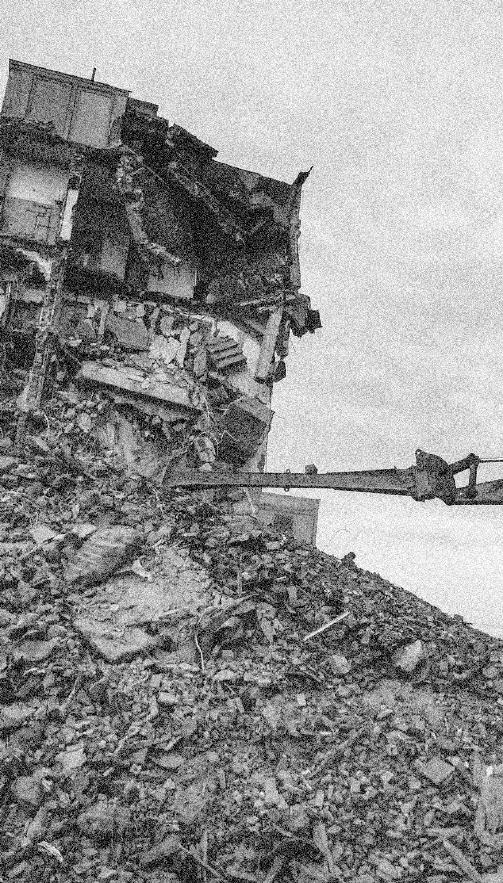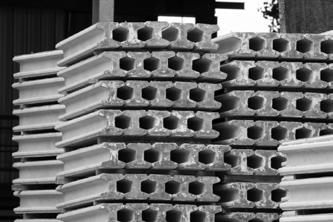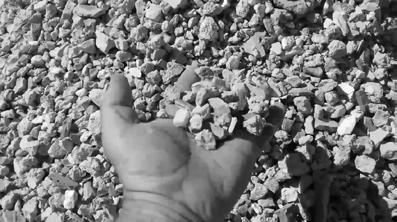
4 minute read
2. THE PROBLEM
We use poetry to create but violence to eliminate.
Following that one-time used life cycle, architectures are born in the expectations but silence in disregards. e development of society is established on countless building’s death. However, the dead body of buildings cannot return to nature again. It is because we are at a stage of only knowing how to create things without discovering or simply just ignoring there is also a need to design how things end.
Advertisement
“When I was a kid, it seemed like they made something new everyday. Some, gadget or idea, like every day, was Christmas.”
- Interstellar4
In the one-time architecture life cycle, the material used cannot return to nature in the short term. e natural decomposition speed cannot catch up with the updating speed. We design with poetry but end it with violence. It is sad to see the crashing of architecture is how it ends.
4. Interstellar, directed by Christopher Nolan (2014; United States: Paramount Pictures, 2015), https://www.imdb.com/title/tt0816692/. 5. Ali Morris, “Zaha Hadid Architects reveals progress on Beijing skyscraper with ‘world’s highest atrium’,” Dezeen, published August 15, 2017, https://www.dezeen.com/2017/08/15/zaha-hadid-architects-beijing-sky scraper-leeza-soho-under-construction-photographs/. 6. Luke Fiederer, “AD Classics: Pruitt-Igoe Housing Project / Minoru Yamasaki,” Archdaily, published n.d., https://www.archdaily.com/870685/ad-classics-pruitt-igoe-housing-proj ect-minoru-yamasaki-st-louis-usa-modernism?ad_medium=gallery. 7. Oliver Wainwright, “ e case for ... never demolishing another building,” e Guardian, published January 13, 2020, https://www.theguardian.com/cities/2020/jan/13/the-case-for-never-de molishing-another-building.



If the architecture’s evolution for this time should come from the discussion about the life cycle instead of form and tectonics? At least nd a poetry way for the ending as well.
Fig.7. Blueprint5 Fig.8. Demolition6 Fig.9. Accumulation7
e existence life cycle analysis
e architectural majority material, concrete, is the hardest to reuse and recycle. Normally the solution is downcycled and used for meaningful land ll. Due to the contaminated concrete fragment, it cannot be reused to regenerate new concrete. erefore, architecture still needs to harvest large amounts of sand and rock resources in this unrecoverable way.
8. “How is Glass Recycled?” Momentum Recycling, 2022, https://utah.momentumrecycling.com/glass-recycling-process/. 9. “Metal Recycling,” American Sustainable Recycling, 2017, http://www.americansustainablerecycling.com/metal-recycling. 10. Akiva Blander, “When a Building Comes Down, Where Do Its Materials Go?” Metropolis, published January 30, 2019, https://metropolismag.com/viewpoints/recycling-demolition-buildingmaterials/. 11. Blander, “When a Building Comes Down, Where Do Its Materials Go?”. 12. Blander, “When a Building Comes Down, Where Do Its Materials Go?”. Harvest raw material
Production fabrication
Waste a er use Sand8 Steel8 Concrete








Glass breaking by hummers
Trommel (sorting)
Fluidized Bed Drier (purifying)
Primary Rotary Screen ( ltering)
Electric arc furnace (primary steel making)
Ladle (re ning)
Continuous casting
Billet Crushing (removing impurities)
Sorting ( nding purpose for di erent crushing)
As material is too complex and no renewable, it can only discuss down-cycle processes.9
Glass cullet for reuse Billet
91% 91% ~0%
Colorful glass is barely recycled as there is only little commercial need for these material.10 Rebar and reinforcing in concrete only 71% as solting compoitional material is hard.11
?12
REVERSIBLE REVERSIBLE ONE-TIME

Fig.10. “Screenshot from video of Demolition of Fawley Power Station’s 650 (198m) chimney,” Planetsail, Fawley chimney demolition, 31st October 2021. 14
Violence elimination???
Can we always use violence to x mistakes? Or does the violence workable? e answer is no.
e world is running out of sand and other resources because the materials cannot be recycled. As most of the sand is used in an irreversible way to produce concrete or become a land ll for border expansion, and the sand that could be used is very limited, we are at the edge of sand war13. is means in the short future, we will not be able to make concrete anymore, will we farewell to the giant tower and architecture machine?
erefore, we are at the edge of guring out a way of generating a recyclable architecture life cycle. A new cycle that is not one-time used, a new cycle that allows architecture to match the value of updating. It is time for us to think about how our creations end.
13. Vince Beiser, “Why the world is running out of sand,” BBC, published November 18, 2019, https://www.bbc.com/future/article/20191108-why-the-world-is-runni ng-out-of-sand. 14. PlanetSail, “Fawley chimney demolition,” published October, 2021, Youtube, 1:32, https://www.youtube.com/watch?v=BDvT4G3wq_s.










